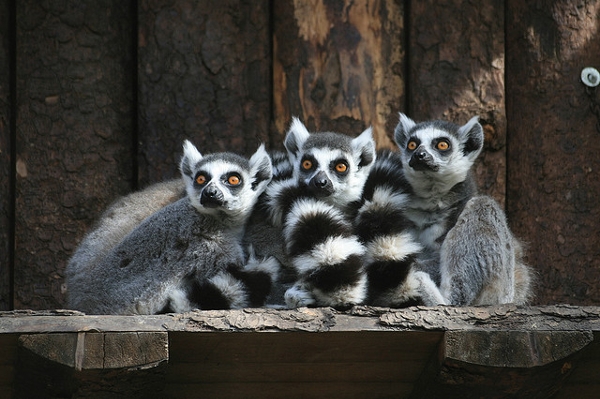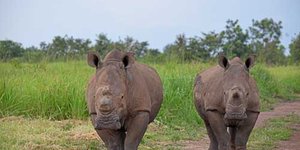Like this article?
Go on, give it a kudu!

Published on July 24 2013
Written by:
Fran
949 views
Made popular by the animated Madagascar movie, many people think of lemurs as cheerful little creatures with big personalities. Roman mythology described these intriguing primates with their pointed noses as ghosts or spirits. But in reality, the lemur is a highly endangered primate – a world conservation priority.
Madagascar is home to more than 100 kinds of lemurs, but sadly, very few people know that lemurs are the world’s most threatened primate group. The detailed taxonomy and classification of the lemur remains disputed, but what we do know is that this primate group is in danger – great danger. Scientists and animal experts believe that lemurs are on the verge of extinction. Considering the history of lemurs in Madagascar, we can see why scientists believe that these special animals are at risk. With the first establishment of human settlements in Madagascar, lemurs as large as giant gorillas roamed the island. Today, these and a number of other lemur species are long gone. It is believed at least fifteen lemur species are already extinct! In a recent lemur assessment study, it was found that lemurs may very well be the most endangered wild animals on Earth!
What are causing the Lemur’s conservation risk status?
The island country of Madagascar off the southeastern coast of Africa has a population of 22 million people. But since its early colonization days, Madagascar has steadily bartered its unique biological territories for human settlements and development. Madagascar’s biodiversity is incredibly unique, yet at the same time in an extremely fragile state. Up to 90% of Madagascar’s indigenous forests have now been eliminated by human activity. And without forests as natural habitat, the lemurs cannot exist. Although much of the deforestation took place during early colonization days, most prominently for coffee plantations, more recent deforestation continued steadily. In its current state, Madagascar is struggling to provide for its fast growing population – and with population pressures, people across the island are forced to fend for themselves through burning and logging of forests for land clearing and resources. Sadly, as the people of Madagascar try to make a living off the land, it causes a feverish onslaught on the lemurs. Other threats to Madagascar’s lemurs include illegal hunting and illegal trade. Lemurs are protected by the CITES (the Convention on International Trade in Endangered Species of Wild Fauna and Flora), meaning that it is illegal to trade lemurs or remove them from their homeland.
Madagascar’s greatest selling point
Madagascar’s extremely unique wildlife including its many lemur species, are the country’s greatest selling points. It bears significant benefit for the local population, bringing hope of fauna research, conservation and tourism. The lemur is Madagascar’s wildlife mascot! Tourists can be kept entertained both day and night, as different kinds of lemurs are either nocturnal or diurnal, offering hours of lemur watching and entertainment.
Fending for their spot in the forest
Each lemur also brings different flavor to the Madagascar mix. There’s the bushy-bearded Black and White Ruffed Lemur, the comical Sifaka Lemur known for its tiptoeing sideways shuffle, the well-known Ring-tailed Lemur as well as the lesser known and incredibly small Berthe’s pygmy mouse lemur. This lemur was only recently discovered by zoologists and weighs a mere one ounce (30 grams). This means that you are looking at the smallest mammal on earth! With individual growls and calls, lemurs form close bonds, spending hours playing and grooming each other. Watching these creatures play, wrestling, bumping and batting is extremely entertaining! Sunning is a regular way for many lemurs to start their day. Each lemur finds itself a sunny spot, and take up a yoga pose with hands on knees. Sunning is believed to help lemurs regulate their body temperature, and who knows, it might very well help them mentally prepare for the day ahead in the Madagascar island forests!
Conservationists and wildlife enthusiasts around the world are pleading for the protection of lemurs – and their habitats. Visitors to Madagascar can contribute by opting for lemur sightseeing and guided lemur tours. Madagascar is the golden home of lemurs – and it needs our protection.
Photo credits: some rights reserved by Paolo Dallorso via flickr [Creative Commons]
Has been on: 11 safaris
Seeing beyond the average tourist routes and experiencing local life is my type of travel! Living in South Africa I'm an environmentalist at heart, and I continue to marvel at the beauty of the African continent.
© Your African Safari Ltd, All rights reserved.
Your African Safari is a safari-planning and safari review site. It was created to help support a healthy African wildlife population. All reviews are vetted before being approved and only ethical tours are published

Garamba National Park—an anchor of hope in the Democratic Republic of Congo
Published on January 09 2025
By: R.W.

Namibia imposes new visa requirements
Published on July 25 2024
By: yourafricansafari.com

Do I really need travel insurance or travel protection for my safari?
Published on July 30 2024
By: yourafricansafari.com